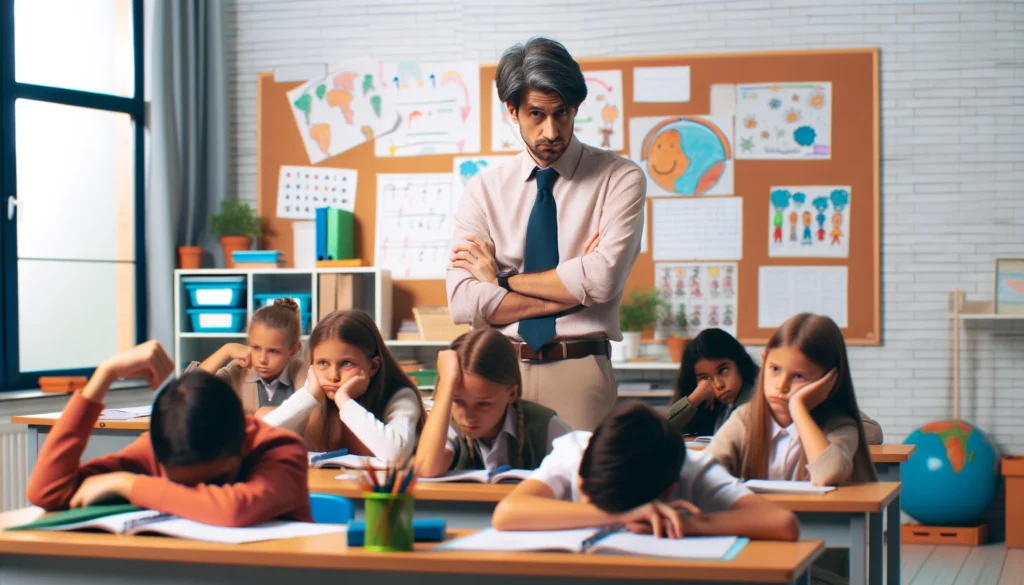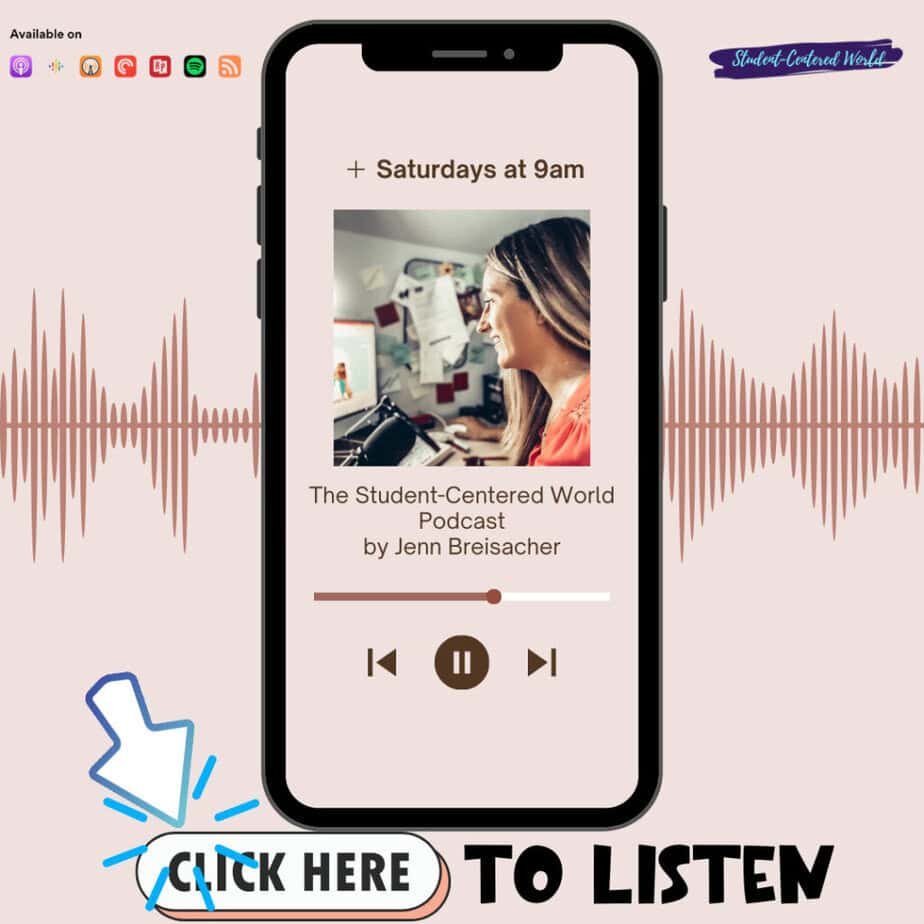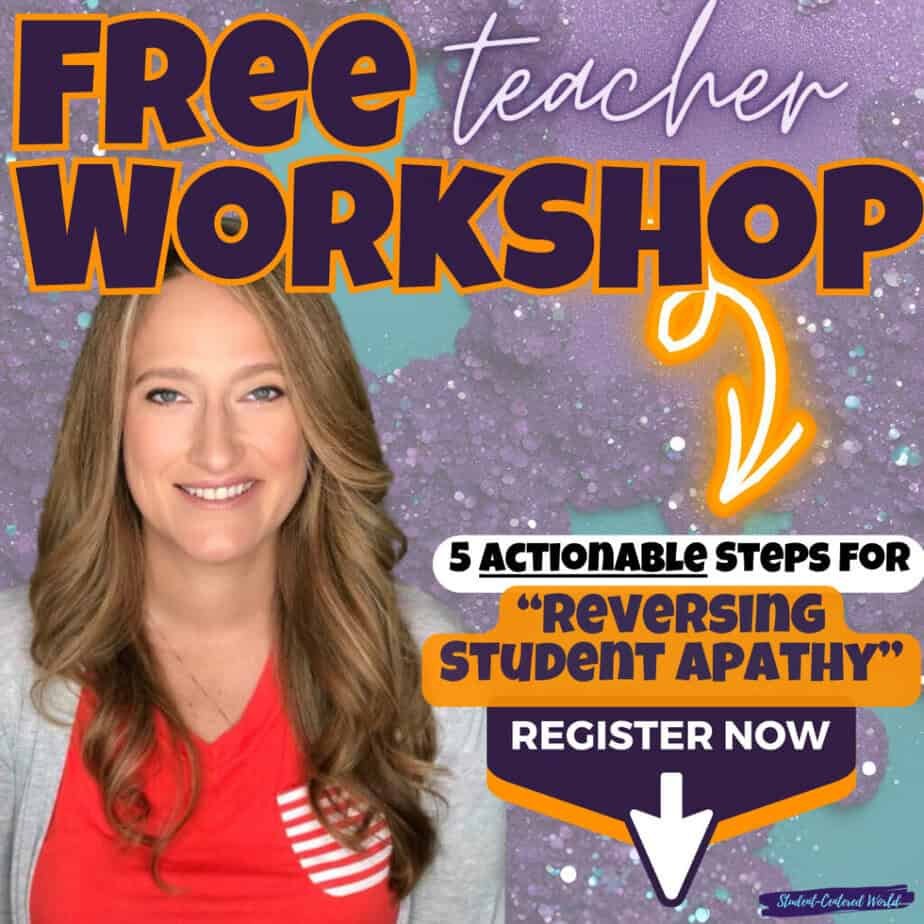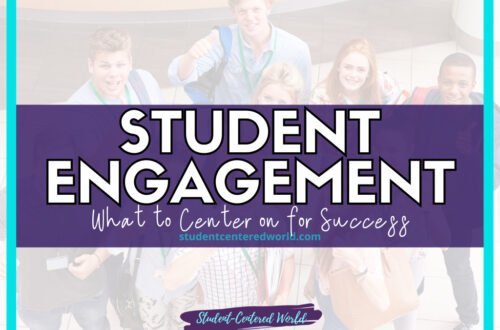How Do You Handle Uninterested Students as Learners?
If there’s one question I’ve gotten more now than ever, it’s simply “How do you handle uninterested students?”. In today’s classroom, that’s an extremely valid question.
Addressing the profound issue of student apathy in our classrooms requires a multifaceted approach, considering that this challenge has been developing over an extended period. The perception that the COVID-19 pandemic solely caused current issues like student disengagement and the high turnover of classroom teachers simplifies a much more layered problem.
Reports predating the pandemic, such as those focusing on teacher shortages and classroom climate impacts on student behavior, suggest that these concerns have been evolving gradually for years. The pandemic merely spotlighted these pre-existing issues at a rapid pace, accelerating them into the public eye.
Understanding the Roots of Student Apathy
Before the worldwide disruptions, subtle shifts in student behavior were already noticeable. Increases in helicopter parenting and a rise in students doing just the bare minimum hinted at a growing disengagement and apathy. This trend, initially overshadowed by the pandemic’s onset, which cast educators as navigational heroes, soon saw teachers facing criticism amidst rising societal divides. I dove deep into this concept to get to the root of the student apathy crisis, and the results I found were incredibly eye-opening.
Students, deeply embedded in these societal shifts, observed and absorbed the conflicts, significantly shaping their social interaction skills and conflict resolution understanding. With restrictions enhancing digital communication reliance, young learners found themselves spending more time online, leading to a shift in socialization patterns. This necessary pivot helped maintain connections yet often lacked the richness of face-to-face interactions, potentially stunting the development of critical interpersonal skills.
This digital shift has transformed social norms for the younger generation, with many now viewing online behavior that others find concerning as typical. The resulting lack of direct social engagement has not only increased loneliness but also diminished genuine social fulfillment, posing additional challenges in fostering social and emotional learning.
Navigating the Challenge of Student Apathy
It’s crucial for teachers to understand that they should not blame themselves for the widespread issue of student apathy. The factors leading to disengagement are numerous and often lie outside the immediate control of individual educators. These can range from societal shifts and changes in family dynamics to the pervasive influence of digital media on young minds. Recognizing that these are systemic issues can alleviate personal guilt and redirect energy toward finding effective solutions. By identifying that the roots of these challenges are complex and multifaceted, teachers can better position themselves to address them without feeling personally responsible for each student’s disengagement.
Once educators can see beyond the initial frustration of dealing with unmotivated or apathetic students, they can begin to dissect the problem more effectively. Understanding the specific factors that contribute to student disengagement within their classrooms or schools can lead to more targeted interventions. This might involve collaborating with family members, counselors, and other educators to gain a holistic view of a student’s environment. With this comprehensive understanding, teachers can develop tailored strategies that address the root causes of disengagement. For instance, if digital distraction is a major factor, strategies might include designated tech-free times or lessons in digital literacy to help students manage their screen time more effectively.
Confronting student apathy effectively calls for educators to deploy diverse strategies aimed at boosting student engagement. This includes fostering a positive learning environment, using small groups to encourage collaboration, and ensuring the subject matter is interactive and relevant. These approaches, integrated into the learning process, are pivotal for rekindling student interest and motivation.
Revitalizing Student Engagement Through Varied Techniques
For classroom teachers, creating a supportive atmosphere where students feel valued goes a long way in maintaining students’ attention. Techniques like class discussions, group work, and practical ways to impart new knowledge can engage even the most reluctant learners. Kinesthetic learners, for instance, benefit from being active during lessons, which can be a great way to involve them in the learning process.
Positive feedback, sincere praise, and fostering a good relationship with students can significantly enhance student motivation, helping them develop a sense of accomplishment and a more positive frame of mind. Moreover, focusing on intrinsic motivation rather than relying heavily on extrinsic rewards can lead to more sustainable student engagement.
In these difficult times, it is crucial for educators, including tutors and heads of year, to maintain open communication and present a united front. Providing students with specific ways to meet learning goals and offering positive interactions can help alleviate the lack of motivation and engage even the most apathetic students. Moreover, integrating insights from diverse resources, such as classic novels like Mark Twain’s “Huckleberry Finn,” can spark students’ interest and connect them more deeply with the learning material.
Ultimately, the best way to combat apathy is by combining these right strategies with hard work and a commitment to student progress. By understanding and addressing the roots of student disengagement in specific and thoughtful ways, educators can make a significant impact, ensuring that learning becomes a dynamic and fulfilling journey for every young person in their classroom.
Long-Term Strategies for Enhancing Student Engagement
Moving forward with a clear plan is essential. After pinpointing the underlying causes of student apathy, educators can implement structured plans to re-engage students. This could include integrating more hands-on learning opportunities that connect with students’ interests and real-world applications of the subject matter. It might also involve setting up a mentoring system where older students who have successfully navigated these challenges help younger ones.
Such strategies not only provide immediate tactics to combat disengagement but also build a long-term framework for a positive learning environment. By systematically addressing the issues with carefully thought-out plans, educators can gradually restore engagement and motivation, leading to a more dynamic and effective educational experience for all students.
In confronting the challenges posed by disengaged students in our classrooms, it’s important to recognize that there is no one-size-fits-all solution. Instead, it takes a variety of strategies and a significant commitment to make a difference. Here, we will explore how educators can best address these challenges and ensure that every student has the opportunity to reach their full potential, using an array of effective tools and insights tailored to revive student engagement.

One of the most powerful tools in an educator’s arsenal is their teaching style. Adapting this to meet the needs of different students—from the unmotivated to the high achievers—can dramatically change student outcomes. For instance, starting each lesson with a “good morning” or a quick note that highlights what will be covered can help students transition from their free time into a learning mindset. It sets a positive tone and prepares them for what’s ahead, making them feel more involved from the start.
Effective classroom management also involves understanding the body language and personal feelings of each student. This awareness can guide teachers in how they approach reluctant or unmotivated students, particularly those uncomfortable receiving praise in front of others. Tailoring feedback to be private can help boost their confidence without putting unwanted attention on them. Additionally, forming small groups can be a good way to foster a sense of belonging and cooperation among students, allowing them to interact more freely and supportively with their peers.
For many students, especially in high school, poor attendance or a succession of failures can lead to a very low self-image and a lack of motivation. School teams, including form tutors and heads of year, can work together to monitor these students more closely, providing them with the support they need at the right time. This might include setting up a meeting to discuss their progress on school-headed paper, giving it a formal and serious tone that underscores the importance of their school responsibilities.
Long-term solutions for tackling student disengagement also involve giving students more control over their learning. Allowing students choice in their assignments or project topics can engage them more deeply in the subject matter, whether it’s a Mark Twain novel in an English class or a YouTube video project for a history lesson. This approach not only caters to their interests but also helps them invest personally in their learning, increasing their intrinsic motivation.
It’s also crucial for educators to remember that every student progresses at their own pace. A student who is uninterested today might just need a little bit more encouragement or a different approach to learning. For example, kinesthetic learners might benefit more from hands-on activities rather than traditional lectures. Therefore, investing time in understanding the unique learning styles and challenges of each student can be a positive step toward re-engagement.
During tough times, like those experienced last week or last year, insider tips from experienced educators can be invaluable. These might include practical advice on managing a classroom during a crisis or strategies for boosting student engagement after a disruptive event. A complete resource kit can also be provided to new teachers, including everything from sample lesson plans to tips on effective classroom management, to help them navigate their early years more smoothly.
Another long-term approach to improving student engagement involves the school environment itself. Creating a positive learning environment where students feel safe and valued can go a long way in encouraging regular attendance and active participation. This includes having a supportive school culture where students feel they can give honest answers without fear of giving the wrong answer, and where their achievements are celebrated, fostering a good relationship between students and teachers.
In dealing with reluctant or challenging students, positive reinforcement and sincere praise are essential. They help build a student’s self-esteem and encourage them to step out of their comfort zone. For students who have experienced a succession of failures, recognizing even the smallest successes can make a significant difference. It’s about showing them that there’s always a better time ahead and that their efforts are valued.
Lastly, for educators themselves, it’s important to maintain open communication with other group members within the school. Whether it’s sharing strategies that have worked or discussing student problems, collaboration can lead to better outcomes for all students involved. Additionally, educators should allow themselves a bit of grace during difficult times. Recognizing that not every problem can be solved immediately or on the first try is crucial. Instead, it’s about making incremental improvements, taking each challenge as it comes, and learning from it for the next time.
In conclusion, addressing the issue of student disengagement requires a multifaceted approach that involves understanding individual student needs, adapting teaching methods, and creating a supportive learning environment. While there is no single solution that works for every student, combining these strategies can help educators make substantial progress in re-engaging students and helping them achieve academic and personal success.
For more in-depth insights and strategies on combating student disengagement, I invite you to listen to our latest podcast episode, where we explore these topics further and share real-world success stories from educators across the nation. Together, we can make a significant difference in the lives of our students. Listen to the podcast here.
Interested in Learning More?
Facing the rising challenge of student apathy, I am thrilled to offer a free workshop dedicated to addressing this critical issue in education. This event is crafted for educators who are eager to find effective ways to enhance student engagement and combat the growing disinterest observed across various grade levels. Again, the workshop is completely free and is designed to empower teachers with the insights and approaches needed to revitalize their classrooms.
This interactive workshop will provide an invaluable opportunity for educators to explore the complex factors contributing to student apathy. By examining underlying causes and discussing broad strategies, participants will be equipped to make meaningful changes in their teaching methods. The sessions are designed to be engaging and collaborative, allowing educators to share experiences and develop a collective approach to overcoming challenges in student engagement.
The workshop will also emphasize the importance of community and network building among educators. Participants will be encouraged to connect with one another, sharing insights and strategies that have been effective in their own classrooms. This network will serve as a continued resource, offering ongoing support as educators implement new tactics to inspire their students.
Highlights of the workshop include:
- A deep dive into the roots of student apathy and its impact on learning.
- General strategies for enhancing classroom dynamics to better engage students.
- The role of educator-student relationships in fostering a more inviting and interactive learning environment.
- Broad discussions on integrating innovative approaches to teaching that resonate with today’s students.
Each educator attending the workshop will gain access to a variety of general resources aimed at enriching the educational experience. Furthermore, an online community will be available for post-workshop engagement, allowing for sustained collaboration and support among peers.
This workshop is an excellent fit for teachers, administrators, and educational professionals who are passionate about reversing the trends of student disengagement and nurturing a more dynamic and responsive educational atmosphere. It presents a unique chance to join forces with like-minded professionals determined to make a significant impact on the academic and personal lives of their students.
As we strive to address these pressing challenges, the workshop offers a platform to unite and empower educators from diverse backgrounds. Registration is essential as spaces are limited, ensuring a focused and productive environment for all participants.
Don’t miss this chance to be part of a pivotal movement in education. Please register today and be part of the solution, helping to reignite enthusiasm and engagement among students and setting them on a path toward a more successful and fulfilling academic experience. Join us as we take proactive steps toward a brighter educational future.









